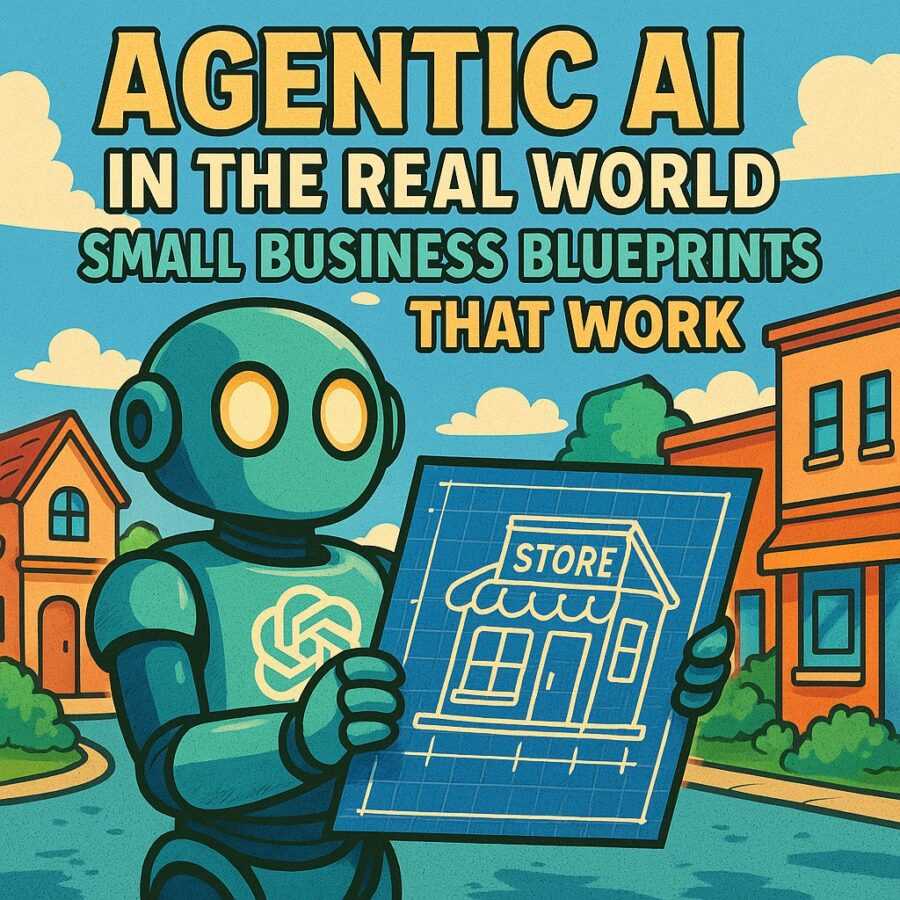Views: 2
In the world of AI hype, Agentic AI In The Real World: Small Business Blueprints That Work promises something tangible: systems that reason, act, and adapt not just respond. Small businesses often lack large teams or deep technical resources. Yet the agentic AI era gives you a lever: if you pick your domain wisely, you can deploy working agents that carry real business load.
This article walks through architectural principles, case studies, and eight blueprints (you can treat eight as a baseline for scale) that you can adapt to your niche. I also map risk, governance, and setup steps so you do not fall into hype traps.
What Is Agentic AI & Why It Matters for Small Business
“Agentic AI” refers to AI systems that do more than generate text or images. They carry autonomy: they can plan, reason, call tools, persist memory, detect anomalies, and recover. They are goal-driven, not prompt-driven. They are closer to digital workers than assistants.
Generative AI systems like chatbots are reactive: you ask, it responds. Agentic AI is proactive. According to thought leaders, agentic AI allows companies to automate entire business processes, not just task slices. (Computerworld)
For small businesses, this shift matters because many key workflows are repetitive, data-driven, and rules-based. With a lean team, you can turn those workflows into agents and convert effort into leverage.
In small businesses, agentic AI use cases include smart customer support, marketing campaign control, financial operations, scheduling, or content pipelines. (vcita.com)
McKinsey calls this transition from horizontal copilots to vertical agents one of the keys to escaping the “gen AI paradox” where AI is used broadly but does not change the economics of value creation. (McKinsey & Company)
Let’s ground this in real blueprints.
Core Design Principles for Agentic AI Blueprints
Before we dive into examples, adopt some architectural guardrails:
- Start small and iterate. Pilot simple agents and then expand. (corexcorp.com)
- Single responsibility. Each agent should execute one coherent domain task.
- Memory and context. Agents must store state across sessions.
- Safety and governance. Define guardrails, audits, approval layers.
- Tool integration. Agents should link to APIs, databases, CRMs, web services.
- Fallbacks and human-in-the-loop. If decisions are borderline, escalate to a human.
- Feedback loops. Agents should learn from outcomes, adjust thresholds, record failures.
- Orchestration and cascades. Agents may trigger or invoke each other when workflows cross domains.
These principles help avoid the common trap of agent sprawl or superficial agents that fail when pushed.
Affiliate Link
See our Affiliate Disclosure page for more details on what affiliate links do for our website.

Five Real-World Use Cases as Proof Points
These use cases show how agentic AI is being used by companies in practice.
- Autonomous ticket resolution and escalation
Some help desk systems now use agents that parse incoming tickets, lookup knowledge base entries, propose responses, and escalate only when needed. (Moveworks) - Smart marketing campaigns with live adaptation
Agents can launch, monitor, and adapt email or ad campaigns based on performance metrics. They can adjust subject lines, budget weights, segmentation on the fly. (vcita.com) - Financial anomaly detection and intervention
Agents monitor expense data or cash flow, detect anomalies or emerging risks, and flag them or even take small corrective actions (e.g. shifting budgets). (IBM) - Content pipelines and scheduling
A content agent might generate topics, outline drafts, schedule posts, and repurpose content. It handles the steps end to end. (IBM) - Intelligent receptionist / customer triage
Rather than simple chatbots, these agents can parse intent, route calls or contacts, schedule follow-ups, or trigger sales outreach. (vcita.com)
These are not hypothetical. They are being implemented now across enterprises and SMBs.
Eight Agentic AI Blueprints That Work for Small Business
Here are blueprints you can borrow and adapt. Each blueprint is modular, and you can mix or cascade them.
1. Customer Triage Agent
Goal: Receive inbound messages (email, chat, contact forms) and triage them intelligently.
- On new contact, agent reads content, classifies intent (support, sales, inquiry, feedback).
- For known issues, the agent drafts a solution or points to existing resources.
- For complex cases, the agent escalates to human, attaching context and candidate responses.
- Logs outcome and learns from escalations (which of its answers succeeded).
You can embed this in your website or CRM. It reduces human load dramatically.
2. Outreach Agent for Lead Nurture
Goal: Run a drip outreach flow for cold or warm leads.
- Agent sequences messages across email or social.
- Personalizes content with profiles.
- Monitors opens, clicks, replies; adapts the next message variant.
- Escalates promising replies for human review.
You can tie this to a creator CRM or list. The agent keeps the nurture alive without constant oversight.
3. Customer Success / Upsell Agent
Goal: Identify and engage clients with upsell opportunity or renewal risk.
- Agent monitors usage, engagement, feedback.
- Identifies clients with low activity or drop in metrics.
- Sends proactive offers or check-in messages.
- Escalates high potential upgrades.
This protects your lifetime value and keeps your base active.
4. Account Reconciliation & Billing Agent
Goal: Automate accounting reconciliation and billing follow-ups.
- Agent cross-checks invoices, payments, overdue accounts.
- Generates reminders, late notices, or offers payment plans.
- Flags anomalies or mismatches.
- Hands off serious delinquency issues to human finance.
In small businesses without dedicated accountants, this covers a vital area.
5. Social Media Content & Engagement Agent
Goal: Publish posts, respond to comments, and engage your community.
- Agent picks content ideas, drafts posts, schedules them.
- Monitors comments / replies, responds where safe.
- Escalates comments that require nuance or brand judgment.
- Maintains member data (who comments, what topics).
This builds social momentum while you focus on creation.
6. Analytics Insight Agent
Goal: Monitor metrics and detect patterns or anomalies.
- Agent watches dashboard metrics (traffic, conversions, churn).
- If a metric deviates beyond threshold, the agent reports insight and suggests a test.
- Optionally, it triggers micro-experiments (A/B tests) and reports results.
This puts your business intelligence on autopilot.
7. Reengagement / Reactivation Agent
Goal: Reach past leads, ex-clients, or inactive users with fresh offers.
- Agent segments stale users, picks messaging angles.
- Sends sequences of outreach that reference past interactions or new offers.
- Tracks responses and funnels back promising users to onboarding or nurture agents.
You reclaim value that would otherwise lie dormant.
8. Partner & Referral Agent
Goal: Discover and automate collaborations.
- Agent scans for possible partners or creators in your niche.
- Crafts outreach proposals for content swaps, promos, or referrals.
- Follows up, tracks responses, and records deals.
- Maintains a referral loop by nudging existing fans/clients to refer peers.
This is how small businesses expand reach without paid ads.
Affiliate Link
See our Affiliate Disclosure page for more details on what affiliate links do for our website.

How to Stitch These Agents Into a Coherent System
Your agents must not act as islands. They must feed each other in a pipeline. Here is a suggested layering:
- Triage Agent handles inbound and funnels into lead nurture or support streams.
- Outreach/Nurture Agent works on prospective contacts.
- Analytics Insight Agent monitors outcomes and triggers new agent actions.
- Reengagement Agent loops in past contacts based on analytics.
- Partner & Referral Agent discovers growth opportunities and feeds them into Outreach.
- Customer Success / Upsell Agent handles ongoing client relationships.
- Billing Agent manages the financial lifecycle in parallel.
- Social Agent amplifies and engages content output across platforms.
Agents share memory and state so that one knows what the other did. For instance, if Outreach Agent got a reply, the Success Agent knows to expect a client in that stream.
Roadmap to Deploy Your First Agentic AI Blueprint
Follow these steps to go from idea to live agent:
- Pick one blueprint (e.g. Triage Agent).
- Define the input and output contract. What triggers the agent? What should it produce?
- Build a prompt and tool interface. Link to your CRM, email API, or database.
- Add safety checks and fallback rules. If uncertain, escalate to human.
- Run in pilot mode (small volume, human monitoring).
- Collect logs and failures. Measure success or error rates.
- Iterate and refine prompt logic.
- Deploy more agents in parallel or cascade fashion.
- Add orchestration, memory sharing, and feedback loops.
- Audit and governance. Ensure traceability, control, and rollback ability.
You will find hands-on guideposts in prompt engineering and system design in my article ChatGPT Prompt Stacks That Triple Your Output In One Hour. You can also explore practical templates on Alt+Penguin in the Downloads section or case studies in the Posts directory.
Risks, Trade-Offs, and Governance
Agentic AI is not magic. You need to manage risk actively:
- Overreach and unintended actions: Agents might act incorrectly or violate business policy. You must sandbox them initially.
- Model hallucinations: Even advanced agents can fabricate facts. Guard by having factual checks or external sources.
- Drift and decay: Over time, prompts may become stale or miss model updates. Schedule prompt reviews.
- Data access and security: Agents often need API keys or database access. Limit scope and audit.
- Agent sprawl: Creating too many agents without coordination leads to chaos. Maintain a registry.
- Governance and traceability: Every decision path should be logged and auditable.
- Project failure rates: Analysts warn many AI/agent projects don’t survive beyond proof of concept. The hype is real. (Reuters)
If you adopt alignment frameworks such as tying agents to stakeholder roles, value constraints, or alignment architectures you can build safer multi-agent systems. For example, the HADA architecture wraps agents in decision alignment layers. (arXiv)
Affiliate Link
See our Affiliate Disclosure page for more details on what affiliate links do for our website.
](https://altpenguin.com/wp-content/uploads/2025/08/veed-ad.webp)
Your Business, Your Domain: Example Walkthroughs
Here are two example scenarios.
Example A: A Content Creator / Coach Business
- Deploy a Triage Agent on your contact page.
- Use Outreach Agent to nurture leads from free content.
- Social Agent publishes and interacts.
- Reengagement Agent reconnects cold leads.
- Success Agent upsells coaching or courses.
- Analytics Agent monitors conversions and content ROI.
You focus on content and coaching; agents handle funnels, messaging, follow-ups, and measurement.
Example B: A Micro SaaS / Niche Software
- Triage Agent handles trial signups, support issues, and upgrade queries.
- Billing Agent matches payments, sends invoices, and handles unpaid accounts.
- Analytics Agent watches plugin usage, trial dropoff, feature adoption.
- Reengagement Agent mails users whose trial is expiring.
- Referral Agent recruits partners or affiliates.
- Content Agent publishes updates or support posts.
Here the agents control much of the customer lifecycle and growth funnel.
Measuring Agentic AI ROI & Performance
Track these metrics:
- Tasks automated per week
- Error or escalation rate
- Time saved (human hours repurposed)
- Revenue or upsell driven
- Conversion lift versus control
- Cost of tools or compute
Begin with baseline metrics before agents. After agent deployment, measure deltas. Use dashboards or connect to your CRM. Adjust agent thresholds when feedback shows misclassifications or failures.
Affiliate Link
See our Affiliate Disclosure page for more details on what affiliate links do for our website.
The Agentic AI Future for Small Business
Agentic AI is still maturing. Many companies stay in pilots. (McKinsey & Company) But the pressure to automate deeper operations is real. As compute and agent orchestration improve, the small business edge lies in adopting early, learning fast, and building in safety.
Architectures like the “agentic AI mesh” show how agents can be composed, orchestrated, governed, and managed across domains. (McKinsey & Company) Emerging frameworks explore how agents and data pipelines coordinate at scale. (arXiv) The job ahead is: map your domain, carve your blueprints, and adopt agentic systems as first principles for operations.
Above all, your business is your best domain expert. Start with the workflows you deeply understand. Use the blueprints here as scaffolding, adapt to your constraints, and let agents take over the repetitive work. Over time, humans steer, agents do.



